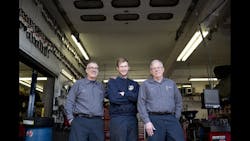Few automotive service centers wield complete control over moving inventory from overseas factories to the final mile. There are simply too many obstacles.
Imagine container ships waiting in line to dock at seaports. Next follows crane operators combing through the overcrowded docks before packing the delivery trucks that begin their cross-country trip to distribution centers, finally replenishing the auto parts stores. But what feels like arm’s reach to the final stop — the repair shop — relative to the thousands of miles the inventories have already traveled, the strains and worries of unfettered access to replacement parts is anything but liberated.
The process of physically landing product orders into the installers' repair bays is fraught with stress, according to four frontline workers' experiences about clearing the supply hurdles. Aftermarket Business World recounts each individual story as the crisis unfolded through December 2021.
"We're working even harder than usual."—Adam Reaver
Recruiting hotshot delivery drivers to meet demand in the summer of 2018 — 18 months before the pandemic exploded, spurred Hunt Valley NAPA Auto Parts to post a job listing over Facebook. But in March 2020, anxiety about an economic collapse resulted in a U-turn in management's rosy outlook.
The 29-store jobber wholesaler based in Maryland slashed its 500-person force to 240, anticipating an uncertain future with the service repair segment. Hunt Valley NAPA cranked down product flow to its outlets throughout Maryland, Pennsylvania and New Jersey, said Adam Reaver, sales manager for those three states.
Unexpectedly, demand rebounded quicker than inventory availability. Two years into the pandemic economy rocked by product shortages and inflation, the independently run NAPA chain recovered 95% of its delivery, dispatch, and stock crews. Despite gradual improvements toward normalcy, explained Reaver, who has worked for Hunt Valley NAPA since the mid-2000s, sourcing and redistributing inventory was no longer the same. To compensate, the staff had to cope with the global supply uncertainties. "We're a little understaffed because of COVID. So, the guys we have on hand are working even harder than usual."
Because of the fuzzy visibility of inbound import arrivals of brakes and the manufacturing of batteries stateside, the fluctuation of on-hand quantities has forced the NAPA organization's hand to search afield. The parts company widened its sourcing activities outside the national hub-and-spoke network. Reaver encouraged his larger commercial installer accounts to load up on stock to help them through lean inventory reserves while Hunt Valley NAPA had stock in its warehouses.
Typically, however, most shops would rarely tie up their monies in hard part inventories. Holding these conversations with shop owners can become uncomfortable, explained Reaver. "Anytime there's issues with supply chain and trying to make the store run smoothly, it always creates a stressful environment," he said.
Most everyone through the Hunt Valley NAPA rank and file began learning how to assimilate to the clogged distribution channels. Predicting when a shipment may be about to arrive became a primary headache of the company's challenges. During the past 24 months, company employees have broken out of their siloed job responsibilities.
"Probably the hardest part when we get low on product is when the shipments finally come in. Our freight team gets so overwhelmed. The sales team comes in and gets them caught back up.” But as Reaver looks past Christmas into 2022, he said, "we're in a better spot right now."
"The most important thing is having it."—John Kachapis
"Prices have taken a backseat to availability right now," said John Kachapis, a manufacturer's representative whose agency's territory covers the Northeast. For the most part, Kachapis curtailed his travels and tabled his aims to enter other industries because the automotive aftermarket has kept him busy blocking and tackling.
Unlike any time in Kachapis' direct links from the factories to his distributor accounts to the automotive commercial service provider, procuring car components has never been more daunting since his introduction to the automotive aftermarket in 1996. To that end, for the auto parts stores, "these folks are working a lot harder for the same sale," said Kachapis, who at the time of his interview with Aftermarket Business World had just ended his day taking a physical inventory at one of his larger wholesale accounts.
The powerlessness over directing freight shipments is universal, Kachapis said. Because of that, worrying over lower fill rates that fluctuate between 50 percent to 70 percent is futile. All that Kachapis can do, he explained, is monitor the daily updates.
Sales pitches and product changeovers have been suspended due to the year-long ocean cargo delays from China until the West Coast ports can smooth out their logistical container jams. What consumed Kachapis' waking hours is reporting accurate time arrivals to his counterparts on the receiving end. More critical is what more can be done to push up the fill factor. "If you're shipping 65 percent to 70 percent, that’s the new 90 percent," Kachapis said.
Elsewhere throughout the marketplace, observed Kachapis, purchasing agents were recalibrating their standards to replenish the shelves and maintain coverage. He said that the product mix has devolved into an inventory of various brands.
Just to finalize the sale, it has become increasingly common for one merchant to buy from other warehouses, jobbers, and off-brand manufacturers to substitute for the primary product line. "You'll be hard-pressed to go into a parts store and see one line. It's going to be a mishmash of different things."
And most manufacturers were stressing out about their inability to move the cargo any faster, according to Kapchapis' communication with them. Conducting business as usual and growing commercial sales has taken a backseat. Given acute shortages, changeovers were out of the question. Few suppliers could ship their existing accounts, much less new ones.
In December, the news surprised Kachapis that Hahn Automotive acquired all 22 Carparts Distribution Centers stores in Maine, New Hampshire and Massachusetts, the epicenter of Kachapis' sales territory. Instead of figuring out how to offset a possible void, he was tracking down backorders.
One reality held constant for Kachapis—his customers relentlessly pressed him to scour any possible supply channel for available products. "It's been extremely hectic...enough that I now call it the floor of the stock exchange."
Further up the distribution stream, noted Kachapis, his manufacturing partners were constantly fielding calls from anxious merchants that otherwise he would take. Despite best efforts, even the top-tier multinational category captains could not force suppliers in China's and the freight forwarders’ hands as to when the imports will reach the American mainland.
"There are days that are much more stressful. But then you reach the point when you admit you can't control it," explained Kachapis.
"Never in my life have I've seen anything like the past two years."—John Rhode
Compared to 2020, the product mix is much different today at Hollenshade's Auto Services. Typically, single-sourcing fully loaded assemblies on brakes and chassis suspension would keep vehicle comebacks low, labor rates stable and productivity high for this 11-bay operation located in Towson, Maryland, about a 30-minute drive from downtown Baltimore.
Downtime is anathema to the 83-year-old shop's reputation for timely automotive maintenance and repair for domestic and foreign makes and models. But instead, Service Manager John Rhode spends his days hunting for application-specific parts to keep the high output operation running smoothly.
"It's not unusual to go between four different suppliers to put a brake job together," said Rhode, who himself, years ago, sold kits to independently owned installers. Not only does product quality potentially suffer from different substitutes— when he cannot obtain Centric brakes or TRW chassis assemblies— the time to complete a repair with piecemeal inputs takes longer.
Notwithstanding the sporadic hot shot deliveries last summer, Hollenshade's technicians have been assembling the parts from scratch into one unit. This extra step had become a source of frustration for this process-oriented operation, whose just-in-time inventory model to keep costs low has been upended.
Tim Hollenshade Jr., owner of the family-run shop, likened it to a manufacturing facility. And absorbing these variable expenses amid persistent inflation is squeezing profits. "That's frustrating because our techs are charging the same for the job. But now we have an extra 30 minutes to one hour that we cannot charge out for," Hollenshade said.
Lately, Hollenshade and Rhode have been coordinating with Hunt Valley NAPA to relieve the supply-chain congestion. Hollenshade credits the parts store for bringing up their delivery driver numbers. Additionally, the collaboration on inventory management and forward purchase notifications on the hot movers has restored some normalcy of timely vehicle repairs. "Hunt Valley provides us with advance notification of what their inventory is," said Hollenshade, who signaled a modest bump in productivity.
What's left for Hollenshade's Auto Services was managing customer expectations. Repair orders were abundant, but punctuality was fleeting. The pre-pandemic days when an automobile arrived by 8 a.m. and out by 5 p.m. is difficult to come by nowadays. Most consumers are feeling the global bottleneck aftershocks, said Tim Hollenshade, in part of the microchip shortage that slowed production of new trucks and crossovers. Thankfully, explained Hollenshade, the bulk of his clients have kept their aging Hondas, Toyotas and Subarus, which has contributed to the shop's overall growth.
Accordingly in that respect, Hollenshade expressed gratitude that his customers were entrusting his team of techs with their cars, many of which are approaching the 15-year-old mark. These car owners have other options, namely factory dealerships. But also, the service operations, Hollenshade claimed, are facing product backlogs dating back three to four months.
Reflecting on these unprecedented events, Rhode shared a parting reflection about the automotive aftermarket: "Never in my life have I've seen anything like the past two years."
About the Author
Alan Segal
Alan R. Segal specializes in project management for suppliers, consultants and retailers. He practiced category management for Sanel Auto Parts Co. and Advance Auto Parts before launching his own firm, Alan R. Segal-Best Business Practitioner. He has worked in the auto care industry since 1991. Connect with Alan on Facebook or LinkedIn.

